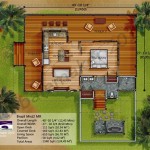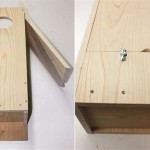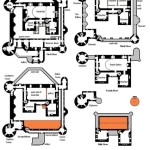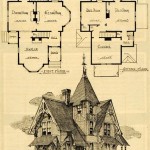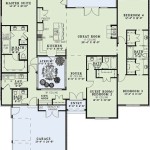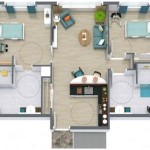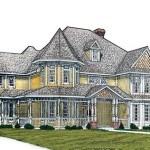Creating house plans is an essential aspect of residential construction, providing a detailed blueprint for the design and structure of a building. House plans encompass floor plans, elevations, sections, and other technical drawings that communicate the architectural vision of a residential property.
Drawing house plans requires a combination of architectural knowledge, technical skills, and a keen understanding of building codes and regulations. The process involves translating design concepts into precise graphical representations, ensuring compliance with building standards and the efficient use of space. Architects and draftspersons use specialized software or traditional drafting techniques to create these plans, which are vital for obtaining building permits and guiding the construction process.
In this article, we will explore the fundamentals of drawing house plans, covering essential elements, drawing tools, and common challenges faced by aspiring draftspersons. We will provide step-by-step guidance on the process, from initial design sketches to finalized drawings, empowering you with the knowledge to create comprehensive and accurate house plans.
To draw house plans effectively, it’s important to consider the following key points:
- Understand building codes
- Use proper drafting tools
- Plan for space efficiency
- Consider structural requirements
- Include electrical and plumbing plans
- Draw to scale accurately
- Create detailed sections and elevations
- Consult with architects or engineers
By adhering to these principles, you can create house plans that are both functional and compliant with industry standards.
Understand building codes
Building codes are essential regulations that govern the design and construction of buildings to ensure safety, structural integrity, and energy efficiency. Understanding building codes is crucial for drawing house plans that comply with local and national standards.
- Zoning codes
Zoning codes regulate land use and building placement within specific areas. They determine factors such as building height, setbacks from property lines, and allowable uses for different zones.
- Building codes
Building codes address the structural and safety aspects of buildings. They specify requirements for materials, construction methods, fire safety, and accessibility.
- Energy codes
Energy codes promote energy efficiency in buildings. They set standards for insulation, windows, lighting, and appliances to minimize energy consumption.
- Plumbing codes
Plumbing codes regulate the design and installation of plumbing systems, including water supply, drainage, and fixtures. They ensure proper sanitation and prevent health hazards.
By familiarizing yourself with building codes, you can ensure that your house plans meet the minimum safety and performance requirements, avoiding costly delays or legal issues during the construction process.
Use proper drafting tools
The choice of drafting tools can significantly impact the accuracy, efficiency, and overall quality of your house plans. Proper drafting tools ensure precision, consistency, and adherence to industry standards.
Drawing board or drafting table
A sturdy drawing board or drafting table provides a stable surface for drafting and prevents your drawings from becoming wrinkled or distorted.
T-square and triangles
A T-square and triangles are essential for drawing straight lines and angles. They come in various sizes and materials, such as metal or plastic.
Scales
Scales are used to reduce or enlarge drawings to a specific scale. Choose scales that are appropriate for the size and complexity of your project.
Protractor
A protractor is used to measure and draw angles with precision, ensuring accuracy in the placement of walls, windows, and other architectural elements.
In addition to these basic tools, you may also consider using specialized drafting tools such as:
- French curves for drawing smooth curves
- Templates for drawing repetitive elements like circles and symbols
- Computer-aided design (CAD) software for digital drafting and design
By selecting and using the appropriate drafting tools, you can create professional-quality house plans that meet industry standards and effectively communicate your design intent.
Plan for space efficiency
Space efficiency is a crucial aspect of house plan design. It involves maximizing the usable space within a building while ensuring a comfortable and functional living environment. By carefully planning for space efficiency, you can create a home that meets the needs of its occupants without being unnecessarily large or costly to build.
Here are some key considerations for planning space efficiency in house plans:
Identify essential spaces
Start by identifying the essential spaces that your house plan must include, such as bedrooms, bathrooms, kitchen, living room, and dining room. Determine the minimum size and shape required for each space based on the number of occupants and their lifestyle.Optimize room layout
Arrange the rooms in a logical and efficient manner. Consider the flow of traffic between spaces and the proximity of related functions. For example, the kitchen should be located near the dining room and living room, and bedrooms should be grouped together for privacy.Utilize vertical space
Make use of vertical space by incorporating features such as lofts, mezzanines, and built-in storage. These elements can add extra usable space without increasing the overall footprint of the house.Incorporate multi-purpose spaces
Design spaces that can serve multiple functions. For example, a spare bedroom can also be used as a home office or guest room. A kitchen island can function as both a food preparation area and a breakfast nook.
By implementing these space-efficient design principles, you can create a house plan that maximizes usable space, reduces construction costs, and provides a comfortable and functional living environment for years to come.
Consider structural requirements
Structural requirements are a critical aspect of house plan design, ensuring the stability, safety, and longevity of a building. By understanding and incorporating structural considerations into your plans, you can create a house that is both aesthetically pleasing and structurally sound.
Here are some key structural requirements to consider when drawing house plans:
Foundation
The foundation is the base of a house and must be designed to support the weight of the structure and resist movement from soil conditions and seismic activity. The type of foundation required will depend on factors such as soil type, climate, and building size.Framing
The framing is the skeleton of a house and provides structural support for walls, floors, and roof. Common framing materials include wood, steel, and concrete. The framing system must be designed to withstand gravity loads, lateral forces (such as wind and earthquakes), and other environmental factors.Walls
Walls are vertical structures that enclose a building and provide support for the roof and other structural elements. Walls can be constructed from various materials, including wood, bricks, concrete, and steel. The thickness, spacing, and reinforcement of walls must be designed to meet structural requirements.Roof
The roof is the topmost part of a building and protects it from the elements. Roofs can be designed in various shapes and styles, but they must be structurally sound to withstand wind uplift, snow loads, and other forces.
By carefully considering structural requirements and consulting with a qualified structural engineer, you can ensure that your house plans meet the necessary safety and performance standards, providing a safe and stable living environment for years to come.
Include electrical and plumbing plans
Electrical and plumbing plans are essential components of house plans, providing a detailed layout of the electrical and plumbing systems within a building. These plans ensure that the electrical and plumbing systems are designed and installed safely and efficiently, meeting the specific needs of the occupants and complying with building codes.
- Electrical plans
Electrical plans show the location and type of electrical outlets, switches, light fixtures, and other electrical components within a building. They also indicate the electrical circuits, wiring sizes, and panelboards required to power the electrical system.
- Plumbing plans
Plumbing plans show the location and type of plumbing fixtures, pipes, drains, and other plumbing components within a building. They also indicate the water supply and drainage systems, as well as the location of water heaters, pumps, and other mechanical equipment.
By including detailed electrical and plumbing plans in your house plans, you can ensure that the electrical and plumbing systems are properly coordinated with the architectural design and meet the specific requirements of the building occupants. This helps to avoid costly changes or delays during the construction process and ensures a safe and functional living environment.
Draw to scale accurately
Drawing to scale is a crucial aspect of house plan creation, ensuring that the plans accurately represent the actual dimensions and proportions of the building. Scaling involves creating a drawing that is a reduced or enlarged representation of the real-world object, with all measurements maintained in the same proportion.
To draw to scale accurately, it is important to:
Choose an appropriate scale
Select a scale that is suitable for the size and complexity of your project. Common scales used for house plans include 1/4 inch = 1 foot, 1/8 inch = 1 foot, and 1/16 inch = 1 foot.Create a scale bar
Draw a scale bar on your plans, which is a graphic representation of the scale used. This allows anyone reading the plans to easily determine the actual dimensions of the building.Use accurate measuring tools
Use rulers, scales, and other measuring tools that are precise and calibrated to ensure accuracy in your drawings.Pay attention to details
Be meticulous in drawing walls, windows, doors, and other architectural elements to scale. Even small errors in scaling can lead to significant discrepancies in the final construction.
Drawing to scale accurately not only helps to avoid costly errors during construction but also facilitates effective communication between architects, engineers, builders, and other professionals involved in the project. Accurate scaling ensures that everyone involved has a clear understanding of the building’s dimensions and proportions, reducing the risk of misunderstandings or misinterpretations.
Create detailed sections and elevations
Sections and elevations are important components of house plans, providing detailed views of a building’s interior and exterior. They are essential for visualizing the three-dimensional aspects of a structure and ensuring that the design is both functional and aesthetically pleasing.
- Sections
Sections are vertical cuts through a building, showing the interior layout, room relationships, and structural elements. They are used to illustrate the height of spaces, the placement of windows and doors, and the overall flow of the building.
- Elevations
Elevations are orthographic projections of a building’s exterior walls, showing the height, width, and architectural features of each side of the structure. They are used to convey the overall appearance of the building and to ensure that the exterior design is cohesive and visually appealing.
- Details
Sections and elevations should include detailed information such as the thickness of walls, the size and location of windows and doors, the materials used for construction, and any special architectural elements. This level of detail is essential for builders and contractors to accurately construct the building according to the plans.
- Coordination
Sections and elevations must be carefully coordinated with the floor plans to ensure that all elements of the design are consistent and work together seamlessly. This coordination is crucial for avoiding errors and ensuring that the building is constructed as intended.
By creating detailed sections and elevations, architects and draftspersons can provide a comprehensive and accurate representation of a building’s design, facilitating effective communication and ensuring a successful construction process.
Consult with architects or engineers
Consulting with architects or engineers is highly recommended for complex house plan projects or when you lack the necessary expertise or experience. Architects and engineers have specialized knowledge and training in building design, structural analysis, and construction practices. Their involvement can significantly enhance the quality and accuracy of your house plans, ensuring that your dream home meets all safety and performance standards.
Architects can assist you with the following aspects of house plan design:
Design concept and aesthetics
Architects can help you develop a cohesive design concept for your home, taking into account your lifestyle, preferences, and the surrounding environment. They can create visually appealing and functional spaces that meet your specific needs.Space planning and layout
Architects can optimize the use of space within your home, ensuring efficient traffic flow and maximizing natural light. They can help you create a layout that accommodates your desired room sizes, relationships, and adjacencies.Building codes and regulations
Architects are well-versed in building codes and regulations, ensuring that your house plans comply with all applicable requirements. They can guide you through the permitting process and help you avoid costly delays or legal issues.
Engineers can assist you with the following aspects of house plan design:
Structural design
Engineers can analyze the structural loads and forces acting on your home and design a structurally sound framing system. They can ensure that your home can withstand gravity loads, lateral forces (such as wind and earthquakes), and other environmental factors.Mechanical, electrical, and plumbing systems
Engineers can design and specify the mechanical, electrical, and plumbing systems for your home, ensuring that they are efficient, safe, and meet your specific requirements. They can coordinate with architects and contractors to ensure that these systems are properly integrated into the overall design.Energy efficiency and sustainability
Engineers can help you incorporate energy-efficient features and sustainable practices into your home design. They can advise you on insulation, window selection, and renewable energy systems to reduce your energy consumption and environmental impact.
By consulting with architects or engineers, you can benefit from their expertise, experience, and professional guidance. They can help you create a house plan that is not only aesthetically pleasing but also structurally sound, functional, and compliant with all applicable codes and regulations.










Related Posts

